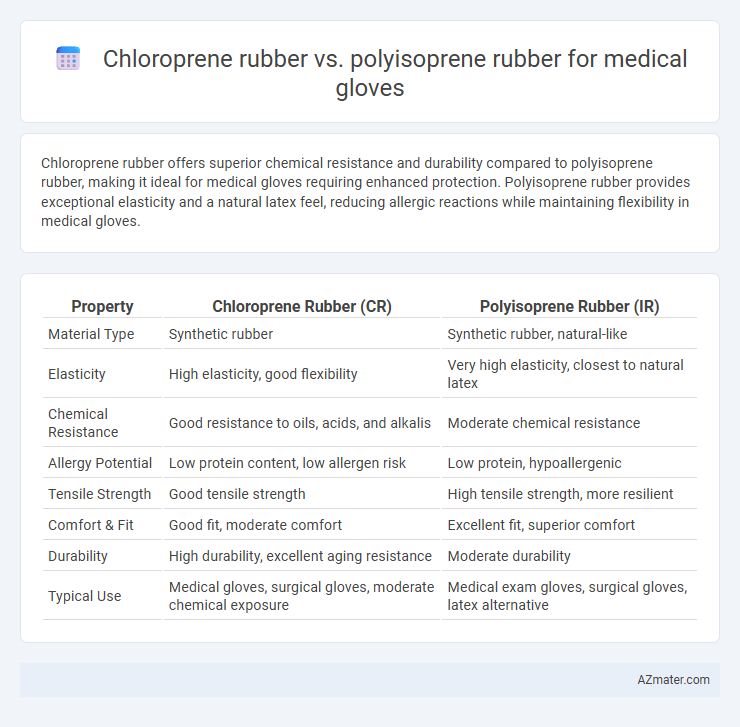Chloroprene rubber offers superior chemical resistance and durability compared to polyisoprene rubber, making it ideal for medical gloves requiring enhanced protection. Polyisoprene rubber provides exceptional elasticity and a natural latex feel, reducing allergic reactions while maintaining flexibility in medical gloves.
Table of Comparison
| Property | Chloroprene Rubber (CR) | Polyisoprene Rubber (IR) |
|---|---|---|
| Material Type | Synthetic rubber | Synthetic rubber, natural-like |
| Elasticity | High elasticity, good flexibility | Very high elasticity, closest to natural latex |
| Chemical Resistance | Good resistance to oils, acids, and alkalis | Moderate chemical resistance |
| Allergy Potential | Low protein content, low allergen risk | Low protein, hypoallergenic |
| Tensile Strength | Good tensile strength | High tensile strength, more resilient |
| Comfort & Fit | Good fit, moderate comfort | Excellent fit, superior comfort |
| Durability | High durability, excellent aging resistance | Moderate durability |
| Typical Use | Medical gloves, surgical gloves, moderate chemical exposure | Medical exam gloves, surgical gloves, latex alternative |
Introduction to Medical Glove Materials
Chloroprene rubber and polyisoprene rubber are key materials used in the production of medical gloves, each offering unique properties suited for healthcare applications. Chloroprene rubber provides excellent chemical resistance and durability, making it ideal for situations requiring extended glove use and protection against harsh substances. Polyisoprene rubber closely mimics natural latex's elasticity and comfort while minimizing allergic reactions, making it a preferred choice for sensitive skin and latex allergy concerns in medical settings.
What is Chloroprene Rubber?
Chloroprene rubber, also known as polychloroprene or Neoprene, is a synthetic rubber widely used in medical gloves due to its excellent chemical resistance, flexibility, and durability. It offers superior resistance to oils, chemicals, and aging compared to natural rubber, making it an ideal material for protective medical gloves, especially for healthcare professionals with latex allergies. Chloroprene rubber gloves provide a comfortable fit, high tensile strength, and good barrier protection against pathogens and contaminants.
What is Polyisoprene Rubber?
Polyisoprene rubber is a synthetic elastomer closely resembling natural latex in elasticity and tactile sensitivity, making it ideal for medical gloves requiring high comfort and durability. Its biocompatibility and low protein content reduce the risk of allergic reactions compared to natural rubber, ensuring safer use in healthcare settings. Chloroprene rubber, though also used for medical gloves, offers superior chemical resistance but lacks the natural feel and flexibility that polyisoprene provides.
Mechanical Properties Comparison
Chloroprene rubber exhibits superior tensile strength and enhanced tear resistance compared to polyisoprene rubber, making it more durable for medical glove applications. Polyisoprene rubber offers greater elasticity and improved elongation at break, providing better comfort and fit during prolonged use. Both materials demonstrate excellent puncture resistance, but chloroprene's balanced mechanical properties contribute to increased glove longevity under rigorous medical conditions.
Chemical Resistance and Protection Levels
Chloroprene rubber offers superior chemical resistance compared to polyisoprene rubber, effectively withstanding oils, solvents, and certain hazardous chemicals commonly encountered in medical settings. Polyisoprene rubber, while providing excellent tactile sensitivity and comfort, shows limited protection against aggressive chemicals and organic solvents, making it less ideal for environments requiring high-level chemical defense. Medical gloves made from chloroprene rubber ensure enhanced protection levels against chemical exposure, making them preferable for healthcare professionals handling a wide range of biohazards and chemical agents.
Allergenicity and Skin Compatibility
Chloroprene rubber exhibits lower allergenicity compared to natural polyisoprene rubber, making it a preferred choice for medical gloves in patients with latex allergies. Both materials offer excellent skin compatibility, but chloroprene's synthetic origin reduces protein-related allergic reactions typically associated with natural rubber latex. Polyisoprene rubber provides similar elasticity and comfort but may pose a higher risk for individuals sensitive to latex proteins.
Comfort, Fit, and Tactile Sensitivity
Chloroprene rubber offers excellent comfort and a snug fit in medical gloves due to its high elasticity and resistance to degradation, maintaining flexibility during extended use. Polyisoprene rubber closely mimics natural latex's softness and provides superior tactile sensitivity, making it ideal for precise medical procedures. Both materials ensure reliable barrier protection, but chloroprene excels in durability while polyisoprene maximizes wearer comfort and touch sensitivity.
Durability and Tear Resistance
Chloroprene rubber offers superior durability and enhanced tear resistance compared to polyisoprene rubber, making it ideal for medical gloves requiring extended use and high flexibility. The molecular structure of chloroprene provides increased chemical stability and resilience against punctures, outperforming polyisoprene in rigorous clinical environments. Polyisoprene, while providing excellent elasticity and comfort, tends to have lower tear resistance, making chloroprene the preferred choice for durable and reliable medical gloves.
Cost and Availability Analysis
Chloroprene rubber offers higher durability and chemical resistance for medical gloves but comes with a higher cost compared to polyisoprene rubber, making it less economical for large-scale production. Polyisoprene rubber, closely mimicking natural latex properties, is more widely available and generally less expensive, providing a cost-effective alternative for high-quality medical gloves. Supply chain stability favors polyisoprene due to its synthetic production, reducing dependency on natural rubber fluctuations that can impact chloroprene prices.
Choosing the Right Rubber for Medical Gloves
Chloroprene rubber offers superior chemical resistance, durability, and elasticity, making it ideal for medical gloves requiring enhanced protection and longer wear time. Polyisoprene rubber, closely mimicking natural latex, provides excellent tactile sensitivity and comfort with reduced allergenic potential, suitable for gloves used in sensitive medical examinations. Selecting the right rubber depends on the balance between chemical resistance and tactile performance required for specific medical applications.

Infographic: Chloroprene rubber vs Polyisoprene rubber for Medical glove
 azmater.com
azmater.com